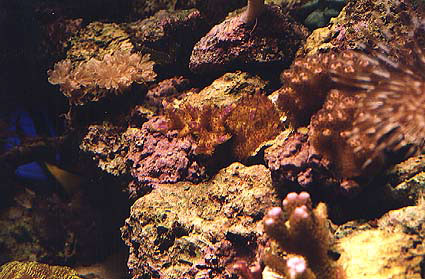![]()
![]()

A variety of different stony corals are growing well in Augsburg's reef aquarium. Pictured here are young colonies of several stony corals (plus one soft coral):
To save money, we have started out with very small captive-propagated coral colonies. These colonies have grown rapidly in the few months they have been in our aquarium. For example, in the month after this picture was taken, the purple-tipped Acropora doubled in size, and the Xenia tripled or quadrupled in size!
A brief history of coral reef aquaria
The stony corals in our reef aquarium are representatives of the sorts of
corals that build reefs. Techniques for keeping such corals alive in captivity
have only recently been developed. Several decades ago, there were only
a handful of people in the world who had successfully kept these corals,
and methods only started to become widely understood in the United States
in the late 1980's or early 90's. Even now, reef tank methodology is evolving
rapidly. Most of the major breakthroughs in reef aquarium husbandry have
been worked out by amateur aquarists, and most large public aquaria only
began setting up reef tanks housing live corals in the late 1990's.
Coral does not = Rock!
Most people think of corals as just pretty white rocks. This is a misconception!
Though most of the rocks in our aquaria are in fact old, weathered skeletons of corals (coral rubble collected in the vicinity of reefs), a coral skeleton bears little resemblance to the live animal that created it. Indeed, calling a coral skeleton a coral is like calling a human skeleton a human.
Live corals consist of many individual anemone-like polyps (often very tiny polyps) that are interconnected by continuous mats of living tissue. In many species (the ones we call stony corals) this mat of living tissue creates a limestone skeleton underneath it that provides support for the colony. When a coral dies and the formerly living tissue rots away, what is left is the familiar white (or in a few species, blue or pink) skeleton.
Animals that live like plants: The strange lifestyles of corals, anemones,
and giant clams.
Though most corals and anemones can capture small animals or other food
with their stinging tentacles, many species have symbiotic algae called
zooxanthellae living within their cells. These algae photosynthesize,
using sunlight energy to manufacture energy-rich food molecules such as
sugars. Some of these products of photosynthesis leak out of the algae cells
and into the coral or anemone cells, thus feeding the animal hosting the
algae. Many corals get MOST of their energy this way, and often the major
benefit gained from catching and digesting prey is that this enhances the
growth of their algal symbionts by providing the algae with "fertilizer",
especially nitrogen and phosphorus. The stony corals that build coral reefs
are particularly dependent upon their resident algae, which is one of the
main reasons why coral reefs only develop in shallow, clear water with good
sunlight penetration. This is also the reason why our aquaria are so brightly
lit. (As mentioned in the caption for the giant clam photo, giant clams
also depend on these same zooxanthellae, which grow at high densities within
the tissues of giant clams).
The brown or beige color of most corals and anemones is caused by the zooxanthallae algae that live within them. Under periods of stress (e.g., caused by high temperatures or sudden increases in light intensity), or if photosynthesis rates by the zooxanthellae are too high, corals and anemones sometimes expel some or all of their zooxanthellae through their mouths. This process, called bleaching, results in white or translucent tissues in extreme cases. If conditions improve, zooxanthellae populations in bleached corals can sometimes recover, but in extreme cases the corals die. Coral bleaching and a variety of coral diseases are increasingly common problems on coral reefs worldwide, sometimes causing great mortality. Unfortunately, the causes for such coral health problems are not completely understood. One likely contributing factor is elevated nutrient levels caused by agricultural runoff and sewage from the land. High nutrient levels are harmful to corals in aquaria as well as in the wild.
Opportunities for the study of coral biology at Augsburg
Students at Augsburg have unique opportunities to come to understand the
true nature of living corals. They can observe the growth and development
of individual coral colonies over months and years, as well as examine small
coral colonies up close using microscopes. This makes it possible to observe
the symbiotic algae within intact, living polyps, as well as skeleton formation
occurring beneath the translucent coral tissues.
Our success with growing stony corals at Augsburg makes a variety of areas of research possible. For example, in Fall Semester 1999 students in Invertebrate Biology will be conducting studies of coral growth rates and coral bleaching under different light levels.
To our knowledge, the opportunities afforded by the reef aquarium at Augsburg are unique among Minnesota Colleges and Universities. To allow us to make the most of these possibilities, we are planning significant expansion of our reef aquarium system in the next few years to accommodate additional student and faculty research.